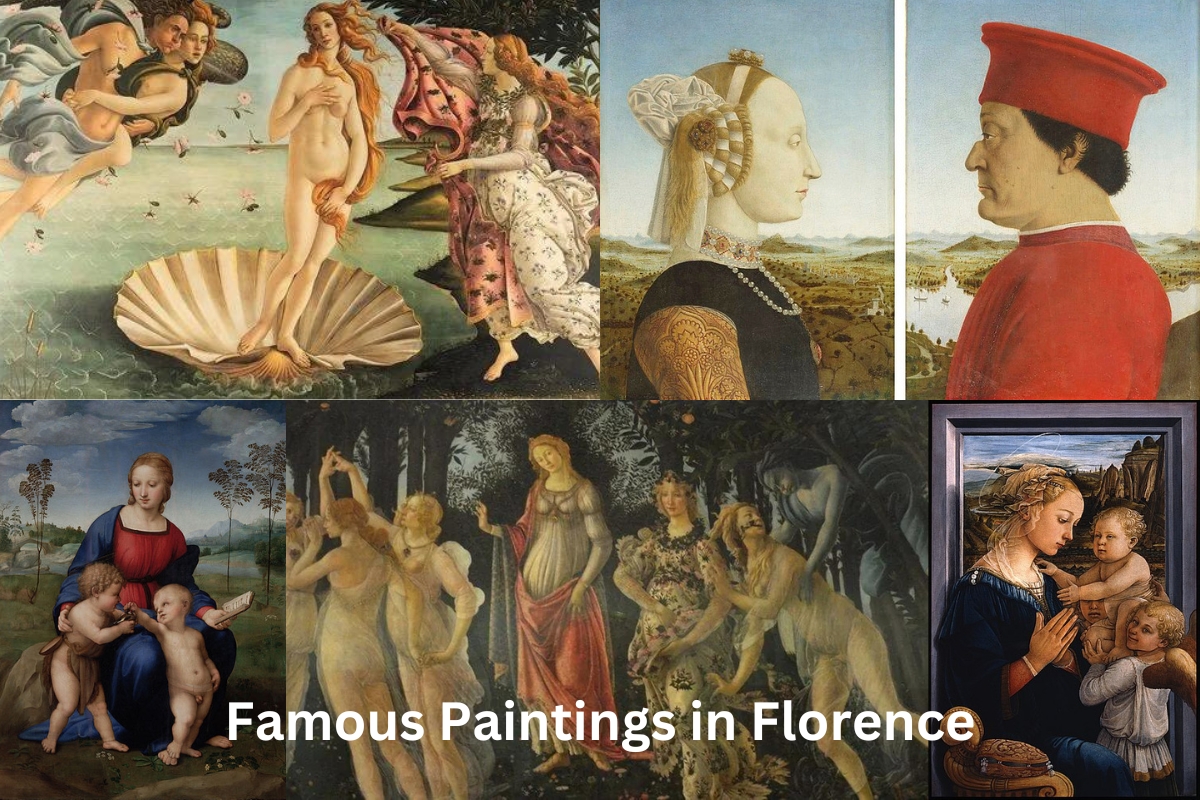Centrally located in Italy, the city of Florence serves as the administrative center of the Tuscany region.
Florence was one of the wealthiest towns in Europe during the middle ages because it served as a hub for trade and banking in medieval Europe.
As a result of its rise to prominence as an artistic, cultural, commercial, political, economic, and financial hub, it is widely acknowledged amongst academics as the city where the Renaissance first began.
In this time period, Florence ascended to a position of enormous significance not only in Italy but also in Europe and the rest of the world.
These days, it is an extremely popular destination for travelers who wish to take in some of the finest collections of Renaissance art found anywhere in the world while they meander about the city’s breathtaking streets.
Below are some of the finest paintings in Florence that can be viewed by the public.
Famous Paintings in Florence
1. The Birth of Venus – Sandro Botticelli
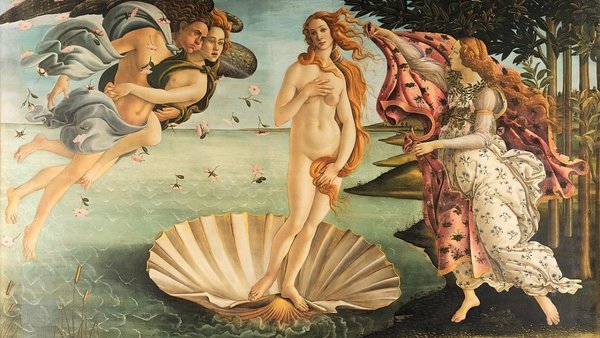
One of the finest Renaissance works of art, Botticelli’s The Birth of Venus shows the Roman goddess Venus being brought to shore on a giant shell.
Another famous Renaissance masterpiece by Sandro Botticelli, the Primavera, likewise has a mythical image.
Both of these works of art were commissioned by the Medici, a wealthy banking family in Florence.
Also Read: Best Museums in Florence
The Birth of Venus is a tempura on canvas painting, when most prior artworks would have been painted on wood panels.
Canvas was preferable to wood because it does not warp when exposed to moisture.
2. Primavera – Sandro Botticelli
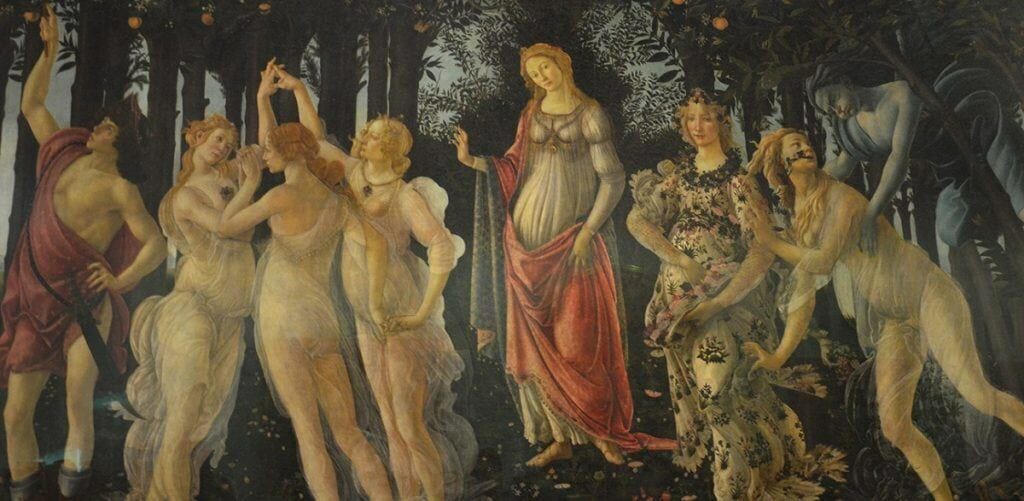
It is believed that Sandro Botticelli created the piece of art that is commonly referred to as “Allegory of Spring” around the year 1482 under the title Primavera, which means “Spring” in English. This title was given to the piece of artwork.
Also Read: Famous Paintings in the Uffizi Gallery
There has been much debate among art historians and critics on whether or not the artwork portrays the changing of the seasons or whether it is making reference to a mythical event.
This artwork is frequently considered to be among the finest examples of Renaissance art not just because of its relevance but also because of the daring use of color that Botticelli employed at the time.
3. Doni Tondo – Michelangelo
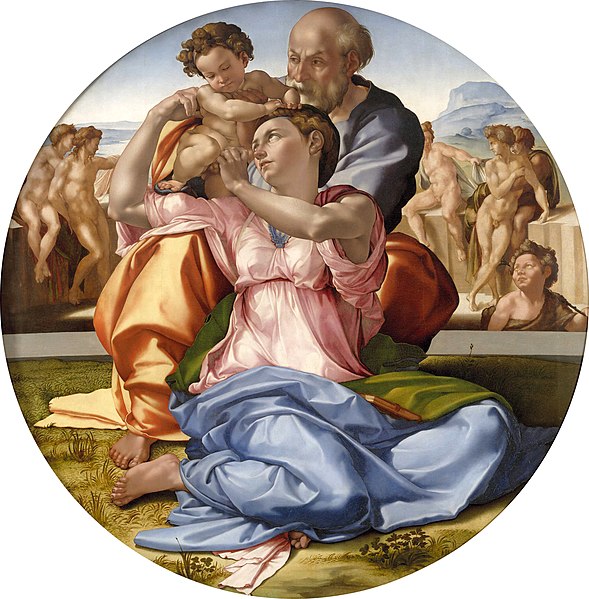
The Doni Tondo was most likely commissioned by Agnolo Doni in order to commemorate the occasion of his marriage to Maddalena Strozzi, who came from a distinguished family in Tuscany.
The piece of art takes the form of a tondo, which derives its name from the Italian word for “round” and was frequently associated with subjects related to the home throughout the Renaissance.
Also Read: Art in Italy
The history of the Doni Tondo may be traced back to the period when Michelangelo arrived in Florence after his first trip to Rome. This was at the same time that the famous Renaissance artist was creating the iconic statue of David at the same time.
It is the only painting by Michelangelo that can be found in Florence, and it is widely considered to be one of the greatest examples of late Renaissance Italian art.
4. Madonna and Child – Filippo Lippi
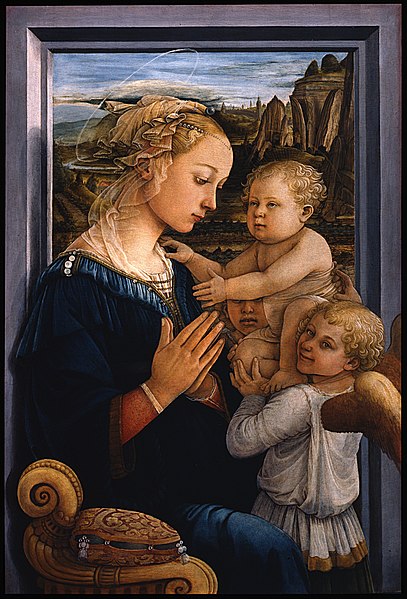
The Italian Renaissance painter Filippo Lippi is responsible for the masterpiece known as Madonna with Child.
There is no record of the exact period that it was created, although the vast majority of art historians agree that it was painted during the latter part of Lippi’s career, between the years 1450 and 1465.
It is one of the few works by Lippi that was not executed with the help of his studio, and it was a significant model for later portrayals of the Madonna and Child, notably those by Sandro Botticelli. This piece is housed in the Uffizi Gallery in Florence, Italy.
The picture is known as “The Uffizi Madonna” since it is kept in the Uffizi Gallery in Florence, which is located in Italy. This is a frequent name for the painting among art historians.
5. Madonna del Cardellino – Raphael
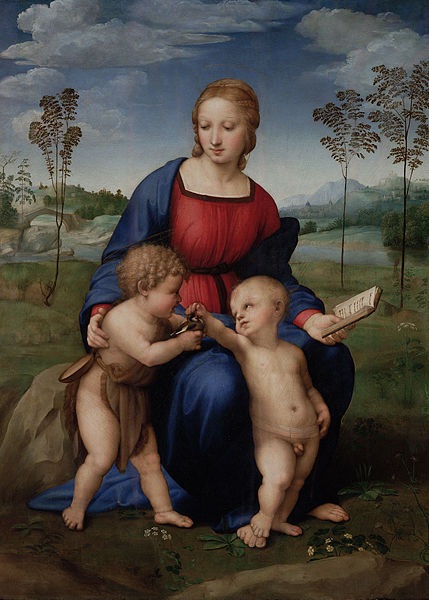
The Madonna del Cardellino, also known as the Madonna of the Goldfinch, is a painting that was created by the Italian Renaissance artist Raphael around the years 1505 and 1506. The painting was done in oil on wood.
After undergoing a process of restoration that lasted over ten years, the picture was eventually brought back to its original location at the Uffizi Gallery in Florence in the year 2008. During the process of restoring the painting, an older version was displayed in the gallery instead.
Raphael gave the Madonna to his friend Lorenzo Nasi as a wedding present when they were married. The house that Nasi lived in was leveled by an earthquake on November 17, 1548, and the painting was shattered into seventeen pieces.
It was quickly removed to be rescued and pieced back together in a hurried manner, despite the fact that the seams were extremely obvious.
During the course of the six-year procedure that began in 2002, a group of people labored to remove the years’ worth of grime that had caused the painting’s color to fade, as well as to repair the damage that had been caused by the earthquake in the distant past.
Before beginning the job, they conducted an in-depth analysis of the previous work by making use of various tools and resources, such as X-rays, CAT scans, reflected infrared photography, and lasers.
The restorers carefully examined the previous layers of rapid fixes that had been applied, and then they removed those layers one by one until the original work by Raphael was finally visible. In 2008, after the restoration was finished, the picture was presented to the public for the first time in the Uffizi Gallery.
6. Annunciation – Andrea del Verrocchio and Leonardo da Vinci
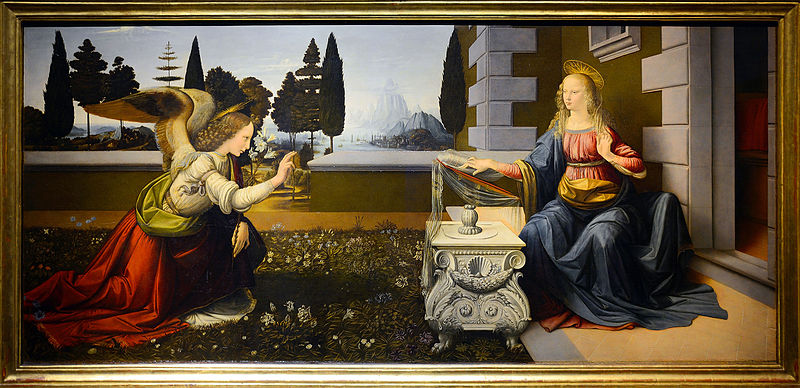
The work of art known as Annunciation was created between the years 1472 and 1475 using oil and tempura on wood. It can be found in the Uffizi gallery in Florence, which is in Italy.
It is possible that Leonardo finished painting the Annunciation when he was in his early twenties when he was still employed in the workshop of Andrea del Verrocchio, for whom he had served as an apprentice when he was younger.
Also Read: Annunciation Paintings
The paintings of Leonardo da Vinci are well-known for the fascinating way in which they depict scenes from the Bible. There is a great deal of symbolism and meaning that is concealed throughout The Annunciation.
There is a lot of information packed into the artwork, and all of it helps to tell the story of what inspired it. For instance, there is a lot of symmetry, balance, and heavenly forces in this picture, which symbolizes holiness and divinity – attributes that are connected with angels who visited Mary. Additionally, there is a lot of symmetry, balance, and divine forces in this painting.
The picture shares many characteristics with previous Leonardesque works, such as “Virgin of the Rocks” and “Saint John the Baptist,” among others.
7. Medusa – Caravaggio

Caravaggio created two versions of Medusa, one in 1596 and another in 1597, each depicting the exact moment that she was murdered by Perseus. Caravaggio was active from 1571 until 1610. He pokes fun at the idea by swapping his own face for Medusa’s, which is meant to show that he is immune to the effects of her menacing gaze.
The strange and intricate design of the picture is said to compliment Caravaggio’s distinct concern with the severity and truth of the subject matter.
It was commissioned by the Italian diplomat Francesco Maria del Monte in order to give it as a gift to the Grand Duke of Tuscany, and it is today kept in the Uffizi Museum in Florence without having any signatures added to it.
The legend of Medusa served as Caravaggio’s inspiration for his subject matter. The image depicts the severed head of Medusa, a monster typically portrayed as a girl with bronze hands and golden wings who wore a head full of poisonous snakes in place of her own hair.
In certain versions of the myth, Medusa also had golden hands. Anyone who looked at her for even a moment was made completely immobilized.
Gorgons were powerful mythological monsters that appeared in ancient Greek mythology. Medusa, along with her two sisters Stheno and Euryale, were referred to as Gorgons.
She was cursed by Athena, and as a result, she was converted into the venomous beast that she was. Medusa was killed by Perseus, who was the son of Zeus and princess Danae. Perseus used a shield that Athena had supplied for him.
In order to show that he was unaffected by Medusa’s menacing gaze, Caravaggio substituted a self-portrait of his own face for the visage of the monster in his painting.
Even though its head has been removed, the creature appears to be conscious even as it is depicted in the artwork as being still in its final moments before being extinguished.
Blood is seen dripping down in multiple streaks, and the jaw is hanging open to its fullest extent, exposing the teeth. A horrifying effect is achieved by creating creases in the brows and making the eyes appear larger.
8. Diptych of Federico da Montefeltro and Battista Sforza – Piero della Francesca
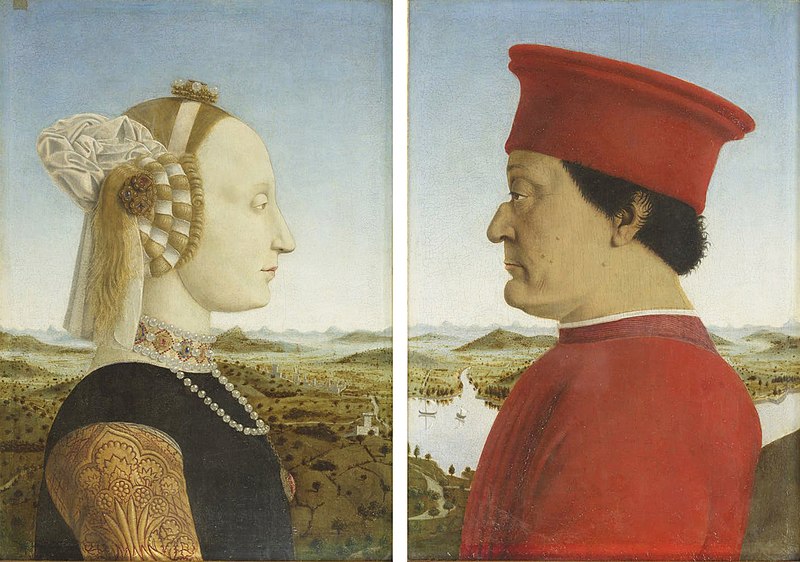
The two oil paintings that make up the Diptych of Federico da Montefeltro and Battista Sforza were created by the Italian artist Piero della Francesca between the years 1473 and 1475.
The Duke and Duchess of Urbino is the name that appears on the website of the Uffizi Gallery, which is the owner of the famous double portrait.
However, due to the fact that Battista Sforza passed away in 1472 and Federico da Montefeltro was not elevated to the position of duke until 1474, Battista was never given the title of duchess.
9. Adoration of the Magi – Leonardo da Vinci
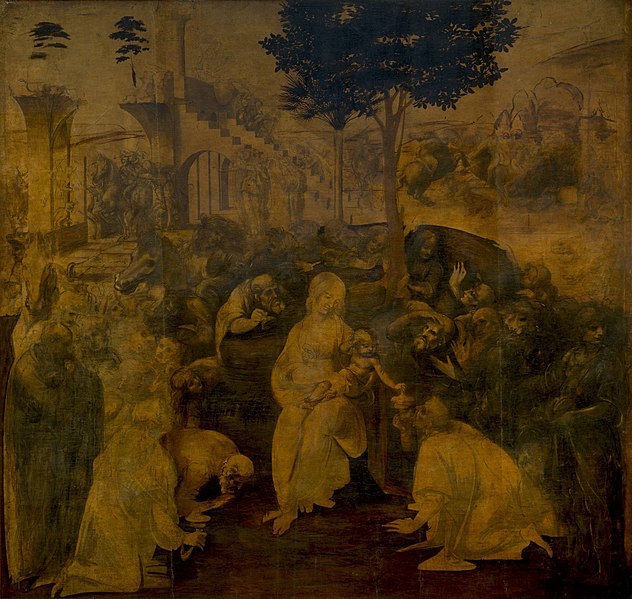
Leonardo da Vinci’s The Adoration of the Magi is an incomplete work from his early career as a Renaissance artist.
The Augustinian monks of Florence’s San Donato in Scopeto commissioned Leonardo to begin this work in 1481, but he left for Milan the next year. Since 1670, it has been on display at Florence’s Uffizi Gallery.
Due to Leonardo’s death in 1482 and the painting’s unfinished state at the time, the contract was given to Filippino Lippi, who created a new Adoration of the Magi in 1496. Additionally, it is displayed in the Uffizi Gallery.
In 1488, Domenico Ghirlandaio finished a painting that developed Leonardo’s idea further.
The six-year repair project at the Uffizi Gallery is finally finished. Years of grime and old varnish have been meticulously scrubbed away.
The final product is extraordinarily vivid, revealing Leonardo’s charcoal outline and marks in stunning clarity. Restoration of the wood panels has also been completed, guaranteeing the work’s longevity for future generations.
10. Madonna of the Magnificat – Sandro Botticelli
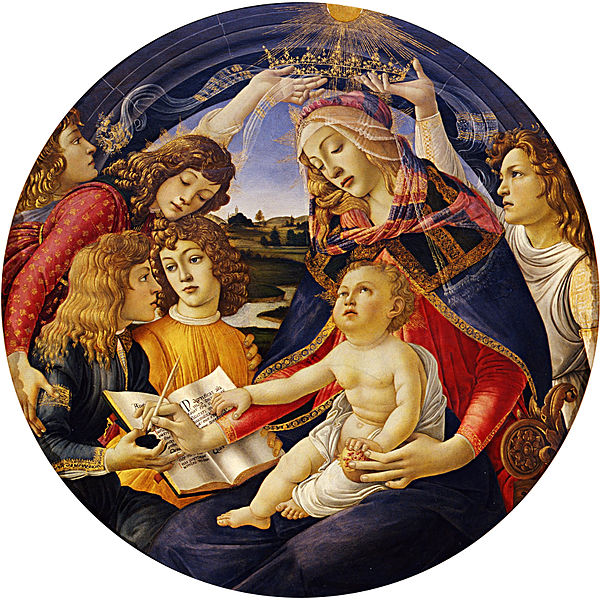
The circular or tondo-shaped artwork known as the Madonna of the Magnificat was created by the Italian Renaissance painter Sandro Botticelli. The original title of the work was Madonna del Magnificat. In some circles, it is also known as the Virgin and Child Surrounded by Five Angels.
The Virgin Mary is depicted in the tondo writing the Magnificat with her right hand while holding a pomegranate in her left hand. Two angels are seen surrounding her and crowning her while the Christ child sits on her lap. It can currently be seen at the galleries of the Uffizi, which are located in Florence.
It is unknown where the artwork came from or when it was created, but in 1784, the Uffizi Gallery purchased it from a private collection. It is possible that it originated in one of the numerous monasteries that were closed down by Archduke Pietro Leopoldo.
There are multiple reproductions of the picture, some of which may be seen at prestigious institutions like the Louvre and the Pierpont Morgan Library in New York.
The angel on the far left who was crowning the Virgin Mary in the copy in the Louvre has been removed, making way for the highest angel in the trio on the far left to display a large spread of his wings.
11. Madonna della Seggiola – Raphael
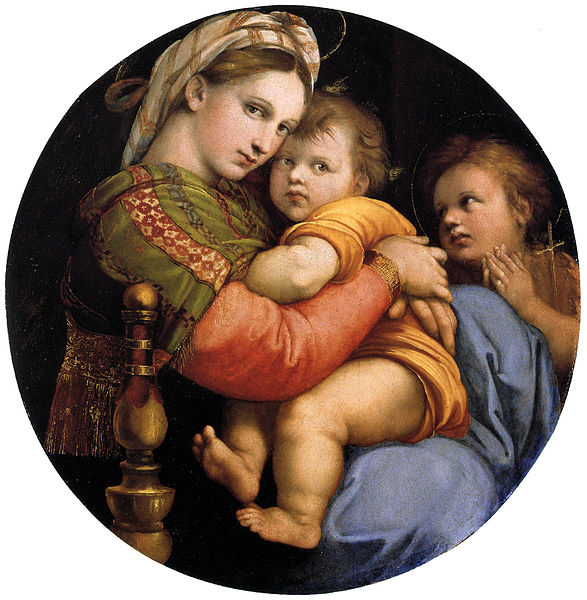
The Madonna della Seggiola, also known as The Madonna della Sedia, is an oil on panel painting of the Virgin Mary that was created by the High Italian Renaissance artist Raphael around the years 1513 and 1514. It is currently kept at the Palazzo Pitti Collection in Florence, Italy.
It is not known who commissioned the picture; nonetheless, it has been in the possession of the Medici family since the 16th century. There is documentation on its arrival to its current location, Palazzo Pitti; yet, it is still unknown who commissioned the painting.
It shows Mary cradling the Christ child while she is seated in a chair. Young John the Baptist looks on reverently from the background. One of Raphael’s Madonnas, the Madonna della Sedia, is considered to be among the artist’s most significant works.
In addition, the painting demonstrates how Raphael utilized the tondo compositional form and how he portrayed the Madonna in a genuine manner.
12. Expulsion from the Garden of Eden – Masaccio
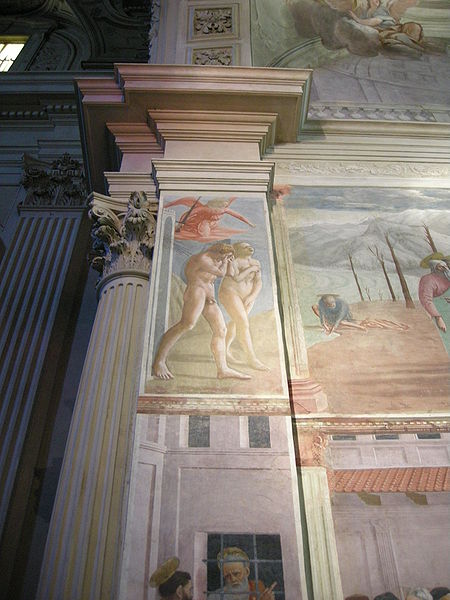
The Expulsion from Eden (Italian: Cacciata degli progenitori dall’Eden) is a fresco by Masaccio, an Italian Early Renaissance artist.
The fresco is a single scene from a cycle painted circa 1425 on the walls of the Brancacci Chapel in Florence’s cathedral of Santa Maria del Carmine by Masaccio, Masolino, and others.
It represents the expulsion of Adam and Eve from the Garden of Eden, as described in the biblical Book of Genesis chapter 3, with a few variations from the canonical version.
13. La Velata – Raphael
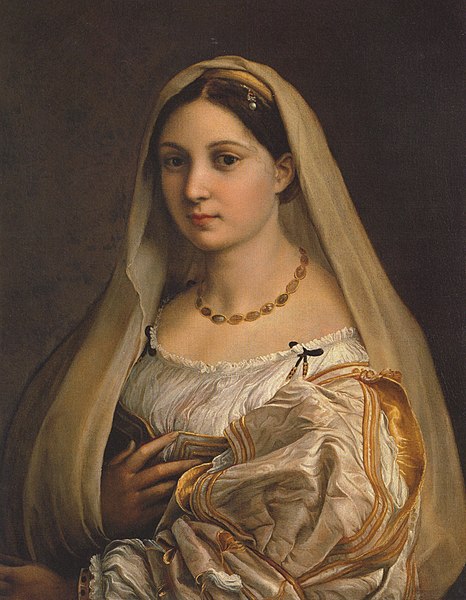
La velata, also known as “The woman with the veil,” is a famous portrait painted by the Italian Renaissance painter Raffaello Sanzio, better known by his nickname, Raphael.
Raphael’s Roman mistress Margherita Luti is traditionally considered to be the fornarina (baker) depicted in this painting. The subject of the painting also appears in another portrait by the artist titled La Fornarina.
Raphael, as was his custom, gave careful consideration to the selection and painting of the subject’s clothes; in this instance, it is breathtakingly lavish.

